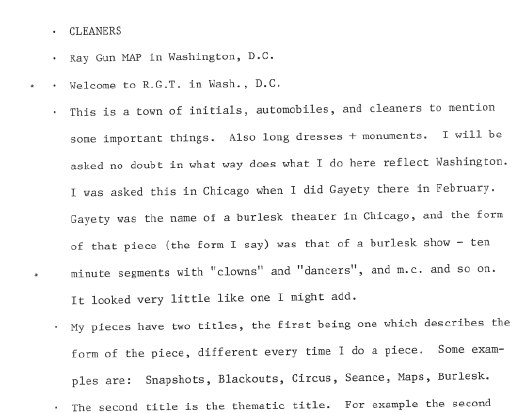
It’s been a few months, and now I’ve been researching it so many places, I can’t remember exactly where I first discovered that Claes Oldenburg did a Happening in Washington DC. And an early one, too. He was invited by Alice Denney, the assistant director of the fledgling Washington Gallery of Modern Art, for The Pop Art Festival she was organizing alongside her pioneering show of Pop Art, “The Popular Image Exhibition,” which opened in April 1963.
Pop was still barely being defined. By including a lecture/tape recorder performance by John Cage and a multi-ring dance event organized by Billy Kluver and featuring Yvonne Rainer and the Judson Church crew, Denney’s expansive view seems to have equated Pop with early 60s avant-garde. If there’s a thread that persisted, it was the artists’ engagement with the popular culture, in contrast to the prevalent self-referential mode of Abstract Expressionists. [The WGMA had just opened with the first Franz Kline retrospective.]
Anyway, it’s a bear trying to find out what this Happening was all about. There was one, there were two. It/they happened at a rug cleaners off of Dupont Circle, and/or in the Gallery itself. It was called Stars and/or Cleaners.
The confusion is partly the ephemeral, had-to-be-there nature of the medium, and partly the fragmented, subjective nature of the accounts I’ve collected so far. Whether written in anticipation of the event or in its aftermath, PR-excited or cynical, they’re incomplete and/or inconsistent. And none is definitive or gives a clear picture of Oldenburg’s intentions or plans, or even what happened. And of course, there are few-to-no substantive reviews.
And then there’s the art historical blind spot that DC inhabits in the art world, and that the art world inhabits in DC. [The Kennedy era seems to be one of the few times that official Washington seemed interested, not just in contemporary art, but in art as it was happening. And that obviously didn’t last, though the institutional vestiges of Camelot and the WGMA linger on, from the NEA to the Art In Embassies program to the Washington Project for the Arts, which is on its third or fourth life right now under my friend Lisa Gold.]
So rather than just write up some mega-post posing as an MFA thesis, I’m going to post an anthology/bibliography for Stars, which will include the articles and accounts I’ve found, plus some interviews I’m doing with folks who were involved with the Happening itself. I’ll keep this post updated with links as I go:
Claes Oldenburg: Raw Notes (1973) contains “Documents and scripts for the performances: Stars, Moneyhouse, Massage, The Typewriter, with annotations by the author. It was republished in 2005.
It turns out Stars was originally called Cleaners, after its first chosen/intended venue. The dates were April 23 & 24, 1963:
This is a town of initials, automobiles and cleaners to mention some important things. Also long dresses + monuments. I will be asked no doubt in what way does what i do here reflect Washington…
My pieces have two titles, the first being one which describes the form of the piece…The second title is the thematic title.
Oldenburg selected Aristo Rug Cleaners, located on P Street around the corner from the WGMA. His notes mention the activity of the site, and how “the interaction of white shirts and brown and black (employees)” embodied the city itself.
After a visit to Washington for the purpose of using the place [the cleaners], I did form the title STARS, already more specific than the first stage. This came from seeing very clear stars in the sky on the last moment of my visit and seemed to concentrate certain physical properties of the place, f. ex. the patriotic motif. The radiated way the streets are built. But the title was still abstract in that it was achieved part from a particular place in Wash. where the piece might be done.
Then Oldenburg set out to design the event, collect props, and cast all his players during a two-week preparatory visit. Next up will be a friendly preview of the performance from that prep period by Washington Post columnist Art Buchwald.
